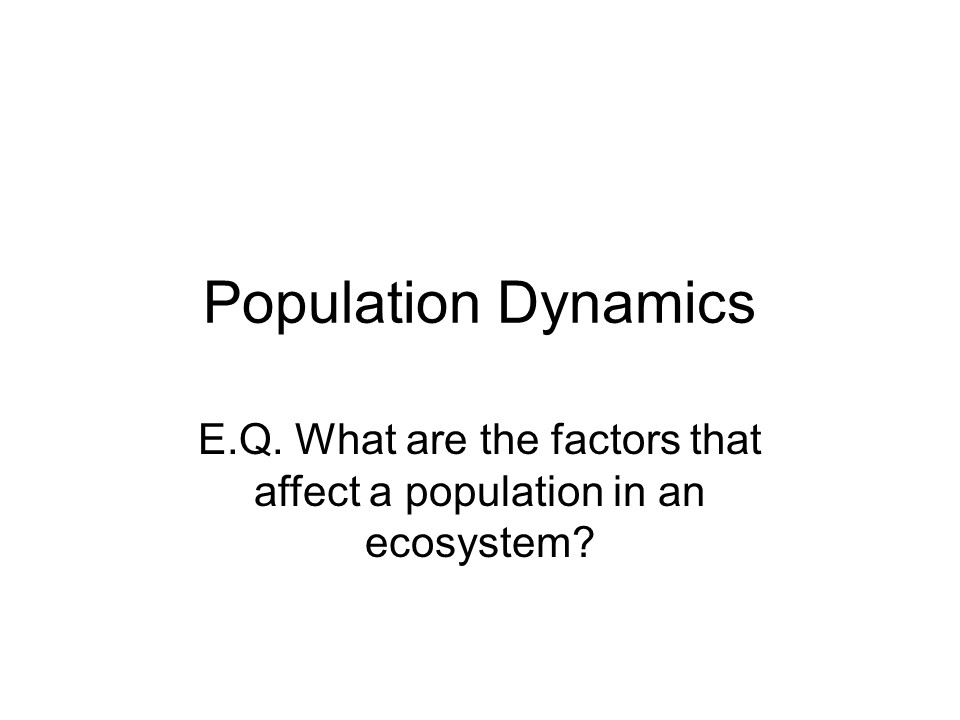Population Dynamics - PowerPoint PPT Presentation
1 / 21
Title: Population Dynamics
1
Population Dynamics
- E.Q. What are the factors that affect a
population in an ecosystem?
2
3
Population characteristics
- Population density
- Population range
- Population growth rate
- Population limiting factors
- Density-independent
- Density-dependent
- Spatial distribution or dispersion
- Uniform
- Clumped
- Random
4
- Map shows Current (dark green) and Historic
Range (light green) of Grizzly Bears in North
America - What is your best hypothesis about the reasons
for the change in the population range of grizzly
bears in North America? - What geographical feature seems to most strongly
determine the population range of the grizzly
bear?
5
Population characteristics
- Population density the number of an organism
(species) that lives in a unit area (acre, square
mile, 100 square miles, etc.) - Spatial distribution or dispersion the pattern
of spacing of a population in an area
6
Population characteristics - dispersion patterns
- (a) Clumped dispersion - certain animal species
are grouped in herds plant species sometimes
grow around specific features like ponds or lakes - (b) Uniform dispersion certain animal species
are territorial some plant species produce a
same species toxin that limits reproduction or
settlement within a given range - (c) Random dispersion members of a population
are distributed in a random fashion that is
unrelated to the presence of others
7
Population characteristics
- Population range the geographical area in which
an organism or population can live - Limited by abiotic factors such as temperature,
humidity, rainfall, sunlight - Limited by biotic factors such as competitors,
predators, parasites - Primary limiting biotic factor - food
8
Map A shows Grizzly Bears in North America and
Map B shows Current Range of Polar Bears in NA.
Based on the maps, what can you tell about the
population range and relationship between the 2
species?
Map A
Map B
9
Population characteristics
- Population limiting factors factors that
prevent a population from growing indefinitely - Density independent factors anything that does
not depend on the number of a population in a
unit area. Usually abiotic weather, fire,
pollution - Density dependent factors anything that does
depend on the number of a population in a unit
area. Usually biotic predation, competition,
disease, parasitism.
10
Population characteristics
- Population growth rate the speed at which a
given population grows - Gestation period, natality (birth rate),
longevity, death rate - Emigration individuals organisms leaving a
population - Immigration individual organisms moving into a
population
11
Population growth rate
- Carrying capacity the maximum number of a
population that an environment can support
long-term
12
Population characteristics
- Population density ( of species in an area)
- Population range (latitude, altitude, climate,
etc.) - Population growth rate (births, deaths,
longevity, reproduction rate, emigration,
immigration) - Population limiting factors
- Density-independent (abiotic factors, weather,
climate, carrying capacity) - Density-dependent (disease, competition,
parasites) - Spatial distribution or dispersion
- Uniform
- Clumped
- Random
13
Determining populations
A
B
C
D
14
Determining populations
A
B
C
D
15
Determining populations
B
A
C
D
How do we determine population of species in
ABCD? Population in area A 38 Total population
of ABCD 152
16
Determining populations
A
B
C
D
17
Determining populations
A
B
C
D
18
Determining populations
A
B
C
D
19
Determining populations
A
B
C
D
List the possible explanations for the change in
population dispersion.
20
Determining populations
- Disease
- Parasites
- New predators
- Competition
- Climate change
- Carrying capacity
- Emigration
A
B
C
D
List the possible explanations for the change in
population dispersion.
21
Quiz
- Carrying capacity
- Emigration
- Dispersion
- Population range
- Population density
- Immigration
- of individuals in a population
- Individuals entering a population from outside
- Geographical area a population inhabits
- Pattern of distribution
- Population limit in an area
- Individuals leaving a population































